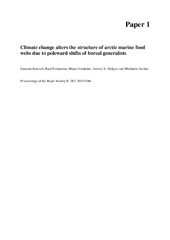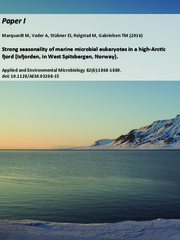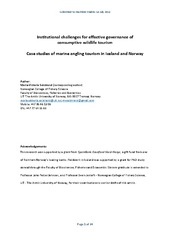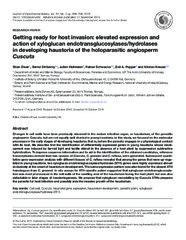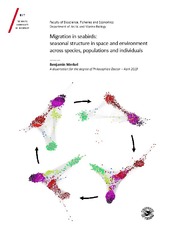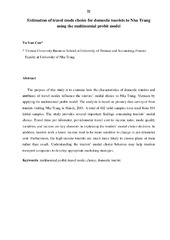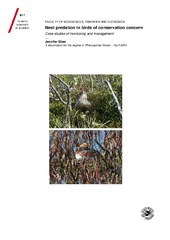Blar i tittel Doktorgradsavhandlinger (BFE-fak)
Viser treff 167-186 av 272
-
Marine food-web structure and community patterns in high-latitude marine ecosystems
(Doctoral thesis; Doktorgradsavhandling, 2016-06-24)This PhD deals with spatial and temporal community patterns in Barents Sea marine food webs and benthic communities in Svalbard. A main aim of this PhD project has been to study how community and food-web structure changes along environmental and climatic gradients, and to elucidate how species respond to climate warming in the Arctic. We used network analysis to study how the network of who eats ... -
Marine microbial eukaryotes in Svalbard waters: Seasonality, community composition and diversity
(Doctoral thesis; Doktorgradsavhandling, 2016-10-18)There is an increasing awareness of the importance and diversity of the microbial community in Arctic regions, but their role in the ecosystem is still largely unknown. Sampling was conducted in Svalbard waters with focus on the Adventfjorden-Isfjorden time series station (IsA, West Spitsbergen) that was sampled frequently from December 2011 to December 2012. The community composition of microbial ... -
Marine tourism fisheries - Challenges of governance and governability Northern Norway as a case study
(Doctoral thesis; Doktorgradsavhandling, 2014-12-17)The research focus for this dissertation is marine tourism fisheries – a sector rapidly growing in popularity in Northern Norway. Data from this research study suggest that the ecological impacts may be more significant than previously thought. As such, it is suggested that marine tourism fisheries be considered separately from recreational fishing, and alongside commercial-scale and small-scale ... -
Mass cultivation of some common coldwater diatoms (Bacillariophyceae): lipids vs. growth conditions
(Doctoral thesis; Doktorgradsavhandling, 2017-02-27)The present study was aimed at investigating northern diatoms as sustainable sources of omega-3 fatty acids widely used and now much needed in salmon aquaculture as well as ingredients to be used in nutraceuticals in the human diet. As known, fish oil is currently the main source of physiologically requisite fatty acids such as eicosapentaenoic (EPA) and docosahexaenoic acids (DHA). Due to the rapid ... -
Måling av produktivitet : en sammenligning av ulike metoder, med spesiell vekt på Data Envelopment Analysis
(Doctoral thesis; Doktorgradsavhandling, 1988-09) -
Mechanisms of Host Plant Infection by the Parasitic Angiosperm Cuscuta
(Doctoral thesis; Doktorgradsavhandling, 2017-05-12)The highly adapted parasitic plants of the genus Cuscuta infect other plants to steal their water and nutrients. They do so by developing specialized organs called haustoria that grow into the tissue of the host plant establishing interspecies connections through which the parasite feeds. Although it has long since been suggested that some manner of modification to host cell walls is necessary to ... -
Meroplankton on Arctic inflow shelves: Diversity, seasonality and origins of benthic invertebrate larvae on the Barents and Chukchi shelves
(Doctoral thesis; Doktorgradsavhandling, 2022-10-05)Planktonic early life stages of marine benthic invertebrates play an important role in dispersal and at times represent a substantial proportion of the zooplankton. Information about the larval communities present on the Arctic inflow shelves of the Barents and Chukchi Seas, however, is incomplete and limited because of infrequent sampling and low resolution of identification. The aims of the work ... -
Metabolic fingerprinting applied in diatom taxonomy
(Doctoral thesis; Doktorgradsavhandling, 2012-06-18)The main aim of this thesis was to investigate if and how metabolic fingerprinting can be applied in diatom taxonomy. Even though both morphology and gene sequences have been shown to be appropriate tools in diatom taxonomy there are cases where these give contradicting results, like in the case of cryptic species. Cryptic species have similar morphology but are genetically different. Another issue ... -
Microbial communities and metabolic networks in Arctic peatlands
(Doctoral thesis; Doktorgradsavhandling, 2014-05-02)Arctic peatlands store more than one sixth of the soil organic carbon (SOC) on Earth. Microorganisms decompose SOC, leading to the production of the greenhouse gases methane (CH4) and carbon dioxide (CO2). Large temperature increases are predicted in the Arctic towards the end of the century (1–6 °C in summer and 2–11 °C in winter). How the microorganisms in Arctic peatlands will respond to this ... -
Microbial community structure associated to Arctic cold seeps
(Doctoral thesis; Doktorgradsavhandling, 2021-11-29)Cold seeps are locations on the seafloor where CH<sub>4</sub> migrates from reservoirs below sediments towards the atmosphere, sustaining thereby a high microbial and macrofaunal biomass and a diversity contrasting from the surrounding seafloor. The oxidation of methane and sulphide are typically the main sources of primary productivity of these ecosystems and have therefore gained a particular ... -
Microbial community variation in an Arctic shelf seafloor. Biogeographic and anthropogenic influences
(Doctoral thesis; Doktorgradsavhandling, 2017-04-21)Studying the spatial patterns of microbial diversity is crucial in order to assess the relationship between community structure and ecosystem function. However, due to methodological limitations in the past, relatively little has been known about the biogeography of microbial communities. The introduction of next generation sequencing technologies from 2005 was a game changer, as DNA sequencing ... -
Microbial diversity and ecology in the coastal Arctic seasonal ice zone
(Doctoral thesis; Doktorgradsavhandling, 2021-03-11)Marine microbes are crucial for the marine food web and carbon cycle. Algae are the main source of organic matter in the oceans with algae blooms triggering reoccurring bacterial succession patterns. Bacteria can recycle nutrients from organic matter coming from land or algae, fueling regenerated primary production. Terrestrial freshwater inputs can have substantial impacts on Arctic marine microbes ... -
Microbial eukaryotes and their functional importance in the Arctic. A Svalbardian perspective
(Doctoral thesis; Doktorgradsavhandling, 2020-11-06)<p>Microbial eukaryotes, including protists and fungi, play diverse functions in virtually all ecosystems. In the High Arctic, their high biomass and diversity reflects crucial ecological importance and the performance of key ecological processes. Protists are the main primary producers in arctic seas, whereas fungi are an important group of decomposers and symbiotic partners of plants in terrestrial ... -
Migration Ecology of North Atlantic Humpback Whales: Mapping Movements throughout the Annual Cycle
(Doctoral thesis; Doktorgradsavhandling, 2023-11-23)Animal migration is a fascinating natural phenomenon where large numbers of animals embark on long-distance journeys, seeking out favorable environmental conditions and prey throughout the annual cycle. In this thesis, a range of techniques was used to fill major knowledge gaps in humpback whale (<i>Megaptera novaeangliae</i>) movement patterns and migration ecology in the North Atlantic Ocean. ... -
Migration in seabirds: seasonal structure in space and environment across species, populations and individuals
(Doctoral thesis; Doktorgradsavhandling, 2019-05-21)Identifying drivers of population trends in migratory species is difficult, as they can face many stressors while moving through different areas and environments during the annual cycle. Their population response to environmental change may in addition be affected by consistent differences in individual behaviour, which are widespread in free-living populations. An understanding of the structure of ... -
Modelling tourism demand, travel mode choice and destination loyalty
(Doctoral thesis; Doktorgradsavhandling, 2013-05-24)This dissertation has three simultaneous purposes: (1) to investigate the effects of both economic and non-economic factors on the domestic tourist flow to Khanh Hoa province in the long term and the short term; (2) to examine how the characteristics of domestic tourists and the attributes of travel modes influence tourists’ choice of travel mode to Nha Trang, Khanh Hoa; and (3) to investigate how ... -
Moderators in the relationship between satisfaction and loyalty of Vietnamese fish products consumers
(Doctoral thesis; Doktorgradsavhandling, 2011-02-26)This study first discusses and tests the strength and possible different forms of the relationships between satisfaction and loyalty. Secondly, it focuses on if, and how, satisfaction strength properties (e.g. involvement, ambivalence, knowledge, and certainty) moderate the satisfaction–loyalty relationship. It also extends to discuss and test the role of perceived risk in the satisfaction–loyalty ... -
"Navigare necesse est". Bio Environmental implications of shipping in the European Arctic
(Doctoral thesis; Doktorgradsavhandling, 2017-06-08)Ocean shipping has for centuries been essential to mankind, and is the most efficient way of transporting goods across the world. With increasing global temperatures, the Arctic ice cap is reduced in thickness and extent, making Arctic shipping more feasible. The thesis looks into the biological and environmental implications of shipping in the European Arctic Seas. A scenario involving a shipping ... -
Nest predation in birds of conservation concern. Case studies of monitoring and management.
(Doctoral thesis; Doktorgradsavhandling, 2015-06-12)In this thesis I have used a variety of study methods at different spatial and temporal scales to explore population processes and management of 2 bird species of conservation concern, common eider and Slavonian grebe, focusing particularly on the role of nest predation in declining populations. I have demonstrated the role of proximate and ultimate causes of nest loss in eider at 2 declining colonies ... -
Neuronal hypoxia tolerance in diving endotherms
(Doctoral thesis; Doktorgradsavhandling, 2010-08-20)The thesis “Neuronal hypoxia tolerance in diving endotherms” sheds light on mechanisms giving diving animals, such as the hooded seal, impressive dive capabilities of 1 hr duration down to 1000 m depth. In spite of enhanced capacity to store oxygen in their body and an ability to reduce their oxygen-consumption, these animals can resurface with blood oxygen values so low that a human being in the ...


 English
English norsk
norsk